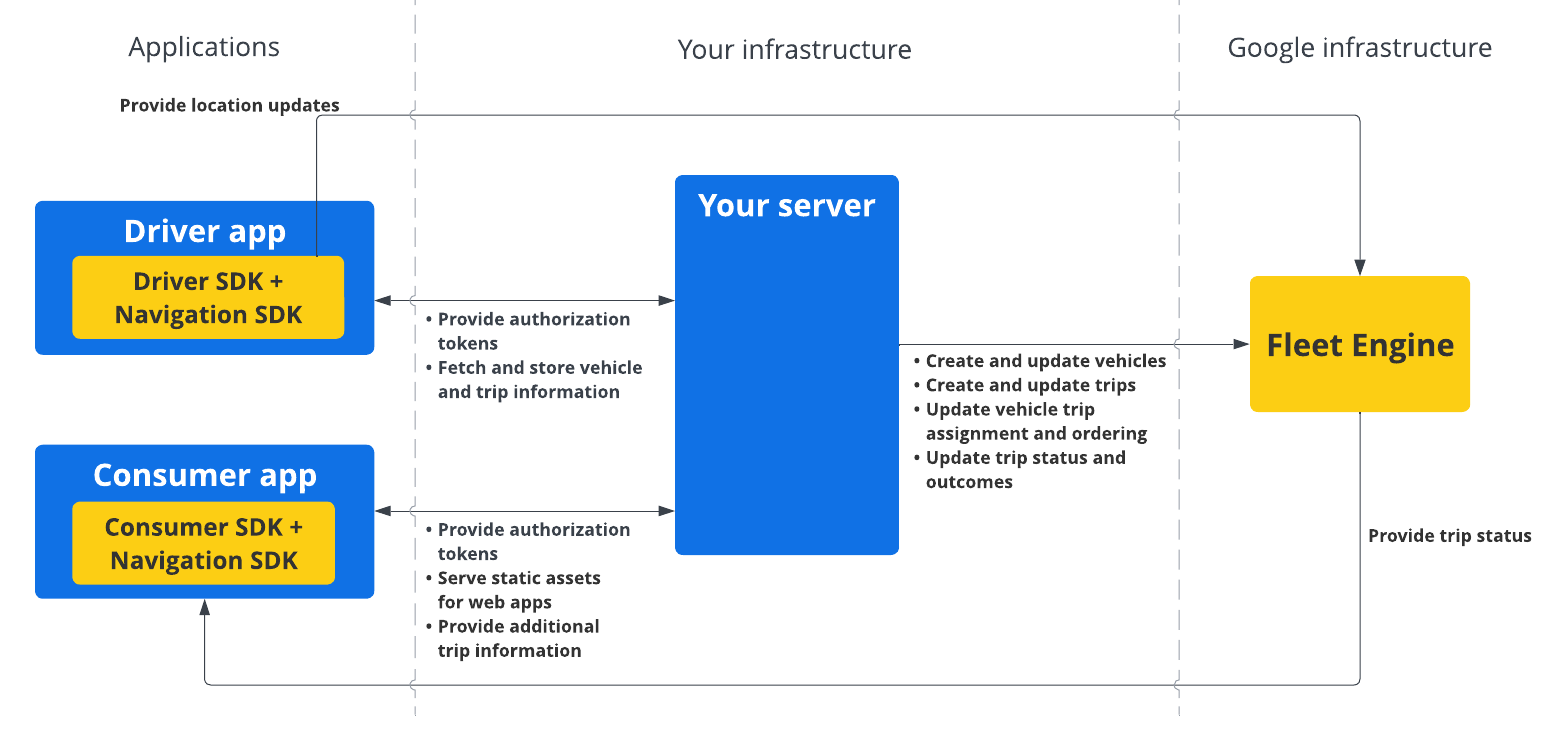Page Summary
-
The Navigation SDK enables turn-by-turn navigation within your mobile apps, seamlessly integrating with Google Maps and Fleet Engine for real-time route and location updates.
-
When used with the Driver SDK, it provides a comprehensive driving experience within a single app, eliminating the need for drivers to switch between navigation and task management.
-
The SDK offers customizable routes, map elements, and navigation instructions powered by Google Maps, ensuring a tailored and efficient navigation experience for drivers.
-
To utilize the Navigation SDK, developers need to set up a Google Cloud project, integrate the SDK into their Android or iOS project, and add the Driver SDK for comprehensive Fleet Engine functionality.
The Navigation SDK lets you to integrate Google Maps turn-by-turn navigation into your mobile applications. Crucially, it provides current route segment and final destination data, which, along with location updates and latitude/longitude coordinates from the Driver SDK, are sent to the Fleet Engine when your driver begins driving. This results in a complete driving experience.
Why use the Navigation SDK?
The Navigation SDK enables easier integration with Fleet Engine for updates to the driver's routes. Using the Navigation SDK along with the Driver SDK enables your driver can use a single app to manage assignments and navigate as they would using their consumer version of Google Maps, without having to switch to another app.
What can you do with the Navigation SDK?
Use the Navigation SDK to communicate the following with Fleet Engine.
- Reliable turn-by-turn navigation instructions powered by Google Maps.
- Customized routes based on the latitude/longitude coordinates provided by the Driver SDK.
- Customized map elements, such as custom markers, overlays, and UI elements to highlight key navigation information and to personalize the navigation experience.
How the Navigation SDK works
The Navigation SDK provides routing information and destination to Fleet Engine, while the Driver SDK provides a stream of location updates, latitude/longitude coordinates, remaining distance, and ETAs. All other vehicle data updates must be sent to the customer backend, which relays the data to Fleet Engine.

How to use the Navigation SDK
The steps below cover a typical use-case scenario for incorporating the Navigation SDK into your driver application:
Android
| 1 | Set up your Google Cloud project | Create a Google Cloud project before using the Navigation SDK. For more information, see Set up your Google Cloud project. |
| 2 | Add the Navigation SDK to your API key | The API key is a unique identifier that authenticates your requests, associate at least one API key with your project to use the Navigation SDK. For more information, see Using API keys. |
| 3 | Set up your Android Studio project | Create an Android project and integrate the Navigation SDK into it. For more information, see Set up your Android Studio project. |
| 4 | Add the Driver SDK to your project | Install and configure the Driver SDK to start taking advantage of all the Fleet Engine features. For more information, see Get the Driver SDK for on-demand trips and Get the Driver SDK for scheduled tasks. |
iOS
| 1 | Set up your Google Cloud project | Create a Google Cloud project before using the Navigation SDK. For more information, see Set up your Google Cloud project. |
| 2 | Add the Navigation SDK to your API key | The API key is a unique identifier that authenticates your requests, associate at least one API key with your project to use the Navigation SDK. For more information, see Using API keys. |
| 3 | Set up your Xcode project | Create an Xcode project and install the Navigation SDK into it. For more information, see Set up your Xcode project. |
| 4 | Add the Driver SDK to your project | Install and configure the Driver SDK to start taking advantage of all the Fleet Engine features. For more information, see Get the Driver SDK for on-demand trips and Get the Driver SDK for scheduled tasks. |
For more information about the Navigation SDK features, see the complete documentation for Navigation SDK for Android and iOS.
